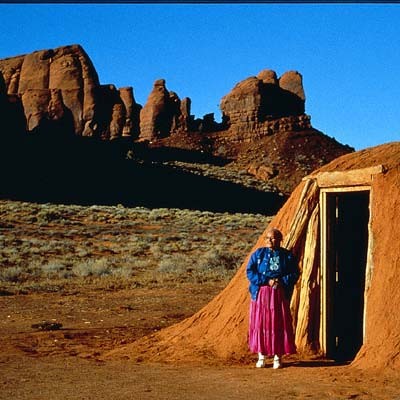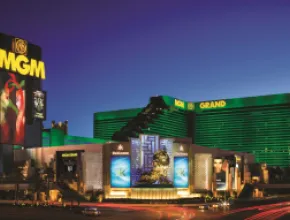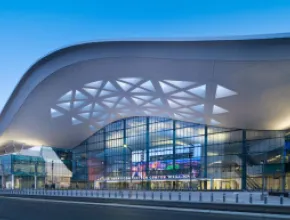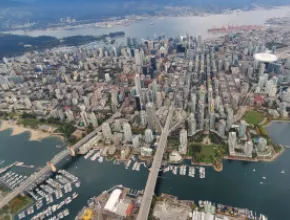It was inevitable that the Southwest’s extraordinary landscapes and diversity of people would spawn extraordinary art. Across Arizona and New Mexico, a centuries-old mixture of desert, mountains and rivers with European, Hispanic and Native American communities has inspired a wide variety of artistic endeavors. And far from being just a big-city phenomenon, the Southwest’s arts communities flourish in—and are even inspired by—a host of small historic towns.
Tapping into the creative side of the Southwest—from art museums and galleries to opera and folkloric dancing—is a surefire way for planners to spice up agendas in Arizona and New Mexico.
ARIZONA
Greater Phoenix
Phoenix is the Southwest’s commercial capital and has also become a destination for contemporary artists, since, like many U.S. metros, the city is experiencing a downtown renaissance as people in search of shorter commutes and urban ambience move in. As a result, the city’s core is becoming more developed and busy at night, says Kathleen Thomas, a Phoenix-based businesswoman who has served on the board of the Contemporary Forum of the Phoenix Art Museum.
“Downtown is really getting a facelift now,” Thomas says. “They’re putting in the light rail, Arizona State University is going downtown, the TGen genetics project went down there—there’s a lot that’s changing. There’s a focus on lofts, on increasing the urban feel of downtown.”
Arts events have been both donors and beneficiaries of re-urbanization, particularly since Phoenix-area arts graduates tend to begin their careers here, according to Thomas.
“You have groups of artists getting together after they get their degrees and putting together a group space,” she says. “There are a lot of good galleries and a lot more experimental work. You’re more likely to see video and installations there.”
Downtown’s increasing number of galleries has inspired one of the nation’s more successful Friday art walks.
One of the more popular gallery sites is the Bentley Projects, a 20,000-square-foot converted warehouse billed as the West’s largest. The facility, which is available for group rental, keeps the space fresh and creative with frequent changes to its exhibitions.
The Paulina Miller Gallery also welcomes an eclectic assortment of arts in a 1,500-square-foot space, which is available for private events.
Planners can also stage events at the Phoenix Art Museum, which unveiled an expansion in November that includes a new 25,000-square-foot, four-level gallery wing, a new canopied entrance, a glass-enclosed lobby, and 40,000 square feet of renovated outdoor space.
The museum is adjacent to the Phoenix Symphony Hall, which completed an $18.5 million renovation and remodeling in September 2005. Both facilities are within walking distance of the Dodge Theatre, the historic, newly restored Orpheum Theatre and the Herberger Theater Center, all of which are available as off-site venues.
Doug MacKenzie, spokesperson for the Greater Phoenix CVB, notes that 1 percent of all funding for Phoenix municipal buildings is dedicated to public art. He cites Louise Bourgeois’ 90-foot mirror for the atrium of the Phoenix Convention Center’s West Wing as an example. In addition, each station in Phoenix’s new light rail system will have an architect and artist who design the stops.
MacKenzie lists other artistic draws in the Phoenix area, including the Frank Lloyd Wright-inspired Arizona Biltmore resort and the Heard Museum, which boasts an impressive collection of Native American artifacts, including kachina dolls and textiles, as well as annual events such as the World Championship Hoop Dance Festival.
Several of Phoenix’s suburbs are also making strong artistic statements. In Mesa, the $100 million Mesa Arts Center is the largest municipal arts center in the Southwest. In just its second year of operation, the center has already hosted more than 400 performances and filled 14 galleries with art. Its four performing spaces range from a 1,600-seat grand theater to an intimate, 99-seat “black box” for contemporary theater. The center is available for private events, and delegates can also participate in art classes at the center, with options such as ceramics or glassblowing.
Tempe, home to Arizona State University (ASU), is another rising arts locale. The university helps drive the local art scene, says Mark McMinn, director of sales at the Tempe CVB.
“Probably the biggest part of our arts scene comes from ASU—the art museums, ceramics studios and so on on campus,” he says.
McMinn also points to Arte es Amor, a celebration of Latino culture featuring events throughout Tempe, as a big draw, and cites the Tempe Festival for the Arts, an annual event that takes over Mill Avenue, the university area’s main retail street.
Meanwhile, Tempe Center for the Arts is scheduled to open in 2007 along Tempe Town Lake. The multimillion-dollar facility will add a 600-seat theater, a 3,500-square-foot gallery space, a 200-seat multipurpose studio, and a 17-acre arts park to Tempe’s cultural inventory.
“We’re selling it as an opportunity for planners to have receptions in the gallery and then go into a performance at one of the two theaters,” McMinn says.
Scottsdale
Like Phoenix, Scottsdale earmarks funds for public art and also features walking tours of many of the city’s 125 galleries.
Scottsdale also has the only dedicated contemporary art museum in Arizona: the Scottsdale Museum of Contemporary Art, nicknamed SMoCA.
Meanwhile, the city is the site of Taliesin West, the former home and school of Frank Lloyd Wright. It’s difficult to overstate Taliesin’s potential impact on Wright’s admirers, knowing that some of his greatest works—including New York’s Guggenheim Museum—were created here. The historic facility is available for afternoon and evening receptions and dinners.
Northern Arizona
Lake Havasu City offers a convenient performance space at the Lake Havasu High School and frequently hosts concerts by the Lake Havasu Symphonic Winds and Lake Havasu Regional Orchestra. The city’s annual Taste of Havasu festival draws people to the city’s compact downtown, which also features a handful of art galleries and the Lake Havasu Museum of History.
In Flagstaff, Jessica Stephens, public relations assistant at the Flagstaff CVB describes a local arts scene that supports dozens of galleries and the First Friday art walk that thrives throughout the year.
“The artists come out to meet and greet, and all the galleries are in the immediate downtown area,” Stephens says. “In addition, the Coconino Center for the Arts includes art exhibits, fine arts and performing arts, and it’s next door to the Pioneer Museum.”
Flagstaff Cultural Partners runs the Coconino Center, which has a 4,000-square-foot gallery and 200-seat theater, both of which are available to groups.
Flagstaff’s Heritage Square anchors the downtown area and is a frequent outdoor performance venue. Ringed with restaurants and art galleries, this urban open space accommodates up to 250 people and sports a built-in amphitheatre.
“A lot of Hopi artists partner with galleries and have shows; there’s a following around the country, so people come here to see specific artists like Shonto Begay,” Stephens says. “Every so often he opens a show and invites others in the tribes to participate in it.”
Sedona’s profoundly beautiful red rock landscape has always inspired a strong arts community, says Jennifer Wesselhoff, vice president of the Sedona–Oak Creek Canyon Chamber of Commerce.
“I think a lot of it is founded in the beauty of the area,” Wesselhoff says. “Sedona attracts artists who are inspired by the landscape.”
AmericanStyle magazine recently ranked Sedona fifth of the top 25 U.S. arts destinations.
There are more than 100 galleries in Sedona, with some of the most famous clustered at the Tlaquepaque Arts and Crafts Village, fashioned after a traditional Mexican town. The village features cobblestone walkways, plazas, fountains, restaurants, and dozens of galleries and shops, and it’s common to see artists at work throughout the development. Planners can also utilize the quaint grounds and unique venues for private group events.
Prominent organizations like the Sedona Gallery Association and Sedona Arts Alliance, as well as facilities such as the Sedona Arts Center, are a further testament to the arts’ place at the local cultural table.
An international film festival, Chamber Music Sedona, and the Sedona Jazz on the Rocks festival round out the local cultural scene.
Southern Arizona
Tucson boasts several cultural institutions that delegates can visit or utilize for group events, as well as several annual arts festivals, including Arts in the City each June and the Fourth Avenue Street Fair in March and December. It also hosts the Tucson International Mariachi Conference each April, attracting both fans and performers.
The Center for Creative Photography, founded by legendary landscape photographer Ansel Adams, collects more than 60,000 works by 2,000-plus photographers for exhibitions, and its PrintView program lets groups view original prints by Adams, Richard Avedon and other legends.
The University of Arizona Museum of Art, Arizona State Museum and Arizona Historical Society are all nearby.
Kimberly Schmitz, director of communications and public relations at the Metropolitan Tucson CVB, also mentions downtown’s Turquoise Trail.
“It’s a walking tour,” Schmitz says. “There is actually a turquoise line painted on the sidewalk, and you can see 22 different historic sites throughout downtown, including galleries, restaurants and sculptures.”
Schmitz adds that public art is huge in Tucson, citing proximity to the thriving artist community in nearby Tubac.
“Southern Arizona is a haven for artists,” she says. “We have a more earthy feel to us, just a more eclectic, personal feel—without taking anything away from Santa Fe.”
Tucson also features multiple performing arts options, courtesy of a city symphony and the Borderlands Theater Group.
Farther south near the California border, Yuma’s performing arts focus is reflected in its Civic Orchestra, Civic Light Orchestra, ballets, and theater. Venues include the historic, newly renovated Yuma Theatre, which seats up to 640 people, while ballet finds a home at Yuma High School’s Snider Auditorium.
NEW MEXICO
Albuquerque
Performing arts are flourishing in Albuquerque, according to Eduardo Diaz, executive director of the National Hispanic Cultural Center.
“There’s a very strong performing arts scene here and lots going on in spoken word—lots of youth-oriented things,” he says.
Visual arts tend to skew toward the traditional, according to Diaz. In his own field of expertise—intercultural relations—he sees potential artistic connections among New Mexico’s Latino and Native American communities.
“There’s a lot to be done in exploring shared traditions, the Indo-Hispano scene—lots of things we could explore in terms of shared cultural traditions,” he says. “There’s a lot of history to uncover and that, I think, is interesting fodder for interesting creative work.”
The National Hispanic Cultural Center is the country’s premier Latino cultural center, with a museum featuring a permanent arts collection, traveling exhibitions and three theaters supporting a full performing arts program. The center is available for private events.
In addition, the Indian Pueblo Cultural Center represents New Mexico’s 19 Indian pueblos, maintaining two museums and a gallery documenting the lives and crafts of the state’s tribes. The center is available for meetings, conferences and special events.
Albuquerque will also host the next Tricklock Company Revolutions Theatre Festival in January, and each June, the city spotlights a week-long international flamenco festival.
On the music side of the aisle is Outpost Productions, a 100-seat theater that primarily spotlights jazz and world music.
Santa Fe
Santa Fe is the Southwest’s arts capital, offering a high concentration of downtown art and sculpture galleries around its classic, Spanish-style plaza.
The Canyon Road gallery scene is becoming another artistic epicenter, while groups can also head to Museum Hill to explore regional arts and culture or stage private events. Museum Hill is now the location of the Spanish Colonial Museum, the Museum of Indian Arts and Culture, the Museum of International Folk Art, and the Wheelwright Museum of the American Indian.
In addition, the Santa Fe Opera presents outdoor performances each summer, and in 2007 it will stage La Boheme and Cosi fan Tutte.
Delegates can also enjoy plays, movies, lectures, and dance performances at the beautifully restored Lensic Theatre, and each February, the Santa Fe Gallery Association holds ARTfeast, a four-day celebration of fine art, food and wine that’s not to be missed.
One truly different site here is the Shidoni Foundry, a bronze-casting facility that can pour up to 1,100 pounds of molten bronze at once, allowing artists to manifest their creative visions in metal. Located in nearby Tesuque, Shidoni’s sculpture garden represents the work of more than 100 sculptors.
Taos
Nearby Taos features 65 galleries packed into a smaller area than Santa Fe, in addition to a scenic alpine setting.
Groups can meet in the Mabel Dodge Luhan House, where Mabel Dodge Luhan ran an informal artistic boarding house that once attracted notables like D.H. Lawrence, Georgia O’Keeffe and Ansel Adams—surely an inspiring setting for groups, particularly since there are still workshops on everything from writing and painting to yoga and welding.
Northwestern New Mexico
New Mexico magazine just wrote about Farmington’s arts community, according to Debbie Dusenbery, director of the Farmington CVB, highlighting the area’s artistic diversity.
“There’s an eclectic group of Native American and American artists here—very traditional and very contemporary, so it’s a good mix.”
Located in the historic Farmington Lumber building, the Artifacts gallery space displays and provides work space for a dozen local artists. The gallery also hosts classes on skills like silk-dying and bookbinding, plus watercolor and acrylics.
“It really is an unusual concept. People can come in and actually see the artists working,” Dusenbery says of Artifacts, which is owned by New Mexico State Rep. Tom Taylor, his wife Bev and their daughter Tara Churchill.
Meanwhile, the Emerson Gallery exhibits a diverse array of Native American artists; the Farmington Civic Center frequently hosts off-Broadway theater; and the Lions Wilderness Park Amphitheatre will run Gershwin’s Crazy for You and Rostand’s Cyrano de Bergerac next summer.
Kevin Holsapple, executive director of the Los Alamos Chamber of Commerce, sees his city’s international scientific prominence as enhancing its artistic options.
“Because [Los Alamos] attracts people from all over the world, you have the Los Alamos Concert Association—probably the premier classical music series in the state,” Holsapple says. “And there are summer outdoor concerts every Friday night—they really draw on our proximity to Austin—so we have a lot of top club acts from all over the Southwest.”
Holsapple notes that Los Alamos has two ballet companies (the New Mexico Dance Theater and the Los Alamos Dance Theater), arts festivals three times a year and events that are unique to the place where atomic weapons were first developed.
“We just had a big event here—The Manhattan Project in Science and the Arts—with a whole symposium day of authors of these books, some of them Nobel-laureate types,” he says.
Southern New Mexico
Spotlighting the arts scene in Las Cruces and in nearby Mesilla is From Rock Art to Pop Art, a brochure filled with arts opportunities. The options, many of which are available for special events, range from the contemporary- and regional-focused Las Cruces Museum of Art to Space Murals Inc., featuring art honoring the U.S. space program and its astronauts.
Chris Faivre, media and publications manager of the Las Cruces CVB, says the arts could be Las Cruces’ best-kept secret.
“There’s a lot of Southwestern influence and Southwest-inspired stuff, but this is a very Mexican scene more than Western,” Faivre says. “With every festival we have, there’s always somewhat of a Mexican flair to it, whether it’s mariachis or folkloric dancers.”
Roswell has a lively arts scene thanks to the Roswell Artist-in-Residence (RAIR) program, which pays studio-based artists a stipend to work in Roswell for a year. RAIR was introduced as a contemporary counterbalance to traditional Southwestern arts and keeps the Anderson Museum of Contemporary Art stocked with photographs, paintings, prints, sculptures, and drawings.
Planners can look to other arts venues, such as the contemporary-focused Roswell Museum and Art Center and the Roswell, New Mexico Fine Arts Gallery.
Brad Treptow, executive director of the Ruidoso Valley Chamber of Commerce, cites a long list of arts-related events in Ruidoso.
“Most of the art walks and art loops take place in spring and summer in the Midtown region, and then there are a couple of arts-and-crafts events,” Treptow says.
The Ruidoso Regional Council for the Arts holds a fine arts festival each November and also conducts art walks, and art-education and art-appreciation activities. It also showcases a chamber music festival each August, while in nearby Alto, the 514-seat Spencer Theater for the Performing Arts, which is available for group rental, stages approximately 40 theater, dance and orchestral events per year.
For More Info
ARIZONA
Flagstaff CVB 928.779.7611
www.flagstaffarizona.org
Greater Phoenix CVB 602.254.6500
www.visitphoenix.com
Lake Havasu CVB 928.453.3444
www.golakehavasu.com
Mesa CVB 480.827.4700
www.mesacvb.com
Metropolitan Tucson CVB 520.624.1817
www.visittucson.org
Scottsdale CVB 480.421.1004
www.scottsdalecvb.com
Sedona–Oak Creek Canyon COC 928.204.1123
www.visitsedona.com
Tempe CVB 480.894.8158
www.tempecvb.com
Yuma CVB 928.376.0100
www.visityuma.com
NEW MEXICO
Albuquerque CVB 505.842.9918
www.abqcvb.org
Farmington CVB 505.326.7602
www.farmingtonnm.org
Las Cruces CVB 505.541.2444
www.lascrucescvb.org
Los Alamos Meeting and Visitor Bureau 505.662.8105
www.visit.losalamos.com
Roswell Visitors Bureau 505.624.7704
www.roswellcvb.com
Ruidoso Valley COC 505.257.7395
www.ruidosonow.com
Santa Fe CVB 505.955.6200
www.santafe.org
Taos County COC 505.758.3873
www.taoschamber.com






